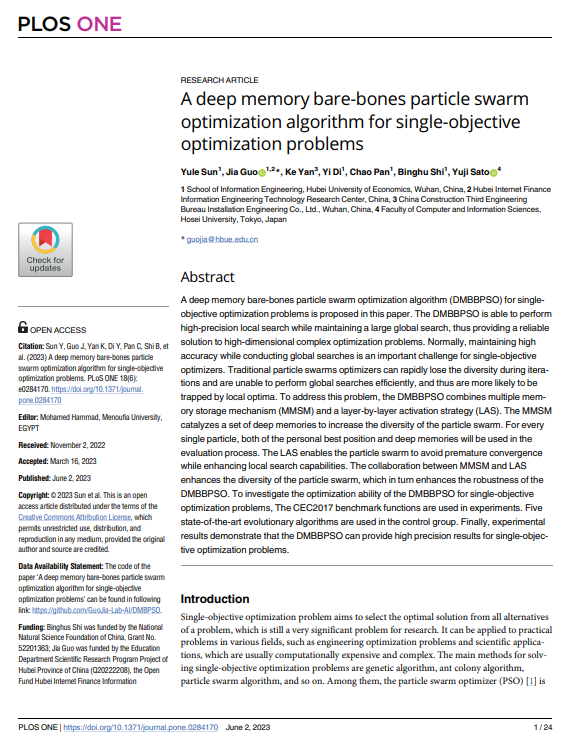本网讯(通讯员:郭佳)近日,tyc8722太阳集团城tyc8722太阳集团城大四学生孙宇乐以第一作者身份在SCIE期刊PLOS ONE上发表了了题为 “A deep memory bare-bones particle swarm optimization algorithm for single-objective optimization problems”的论文。PLOS ONE 被SCIE等众多著名数据库收录,为中科院三区期刊,在学术界有着较大的影响力。该论文提出了一种新的粒子群优化策略来解决单目标优化问题,对传统粒子群算法的效率提升具有重要意义,该论文指导老师为太阳集团城官网人工智能PI团队青年教师郭佳。

Abstract:
A deep memory bare-bones particle swarm optimization algorithm (DMBBPSO) for single-objective optimization problems is proposed in this paper. The DMBBPSO is able to perform high-precision local search while maintaining a large global search, thus providing a reliable solution to high-dimensional complex optimization problems. Normally, maintaining high accuracy while conducting global searches is an important challenge for single-objective optimizers. Traditional particle swarms optimizers can rapidly lose the diversity during iterations and are unable to perform global searches efficiently, and thus are more likely to be trapped by local optima. To address this problem, the DMBBPSO combines multiple memory storage mechanism (MMSM) and a layer-by-layer activation strategy (LAS). The MMSM catalyzes a set of deep memories to increase the diversity of the particle swarm. For every single particle, both of the personal best position and deep memories will be used in the evaluation process. The LAS enables the particle swarm to avoid premature convergence while enhancing local search capabilities. The collaboration between MMSM and LAS enhances the diversity of the particle swarm, which in turn enhances the robustness of the DMBBPSO. To investigate the optimization ability of the DMBBPSO for single-objective optimization problems, The CEC2017 benchmark functions are used in experiments. Five state-of-the-art evolutionary algorithms are used in the control group. Finally, experimental results demonstrate that the DMBBPSO can provide high precision results for single-objective optimization problems.
论文内容详细内容链接: https://journals.plos.org/plosone/article?id=10.1371/journal.pone.0284170

